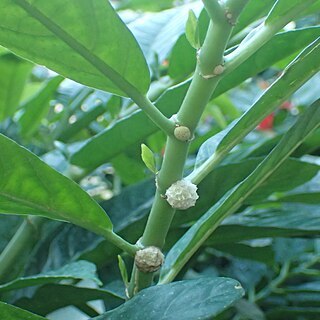Perennial herbs, sometimes shrubs, sometimes epiphytic, stems often rather juicy or succulent, monoecious or dioecious by abortion. Leaves basically opposite, but one leaf of each pair is either reduced or early falling, thus the plants appear to have alternate leaves; lamina very unequal-sided at base, entire, crenate or serrate, rather fleshy; stipules intrapetiolar, fused to the apex. Male inflorescences small pedunculate clusters; ♀ inflorescences capitate, with a fleshy subglobose receptacle on short fleshy peduncles, in the axils of fallen leaves. Male flowers 4–5-merous; rudimentary ovary present, obovoid. Female flowers 4–5-merous, with very short perianth; ovary straight, exceeding the perianth; stigma sessile, penicillate. Achene ovate, partly covered by the fleshy persistent perianth.
Monoecious or dioecious perennial subshrubs or herbs, sometimes epiphytic, usually succulent, without irritant hairs. Leaves alternate or opposite with one of pair small to minute, petiolate, simple, the lamina coriaceous, often asymmetrical, curved, entire, to crenulate-dentate in distal half; stipules small, often caducous. Inflorescence unisexual. Male inflorescence divaricate, cymose; flowers in small receptacles. Male flowers: tepals 4 or 5; pistillode present. Female inflorescence capitulate, fleshy, globose, subsessile to sessile at nodes, often solitary. Female flowers: tepals 3 or 4; stigma subsessile to sessile, shortly ligulate. Achene ovoid, often exserted from perianth. See also Du Puy & Telford (1993: 95).
Leaves distichous, opposite and heteromorphous with one leaf of each pair reduced in size, or leaves apparently alternate with one in each pair completely reduced; lamina crenate or serrate, rather fleshy, penninerved, with linear cystoliths.
Inflorescences unisexual, in the axils of existing or fallen leaves; male flowers in small pedunculate glomerules; female inflorescences capitate with fleshy receptacles on short fleshy peduncles.
Female flowers sessile with a persisting perianth of 4–5 free tepals; ovary erect, symmetrical, with a penicillate stigma.
Perennial herbs, often epiphytic or epilithic, monoecious or dioecious by abortion; stems juicy or succulent.
Male flowers pedicellate, pentamerous (rarely tetramerous), with a rudimentary pistillode.
Achene ovoid, surrounded at the base by the accrescent perianth.
Stipules intrapetiolar, fused.

